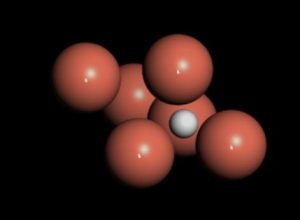This project aims to apply Kinetic Monte Carlo to study dynamic H2 dissociation on a homogeneous surface and to approach traditional Langmuir adsorption model. Fichthorn et al. presented details of theoretical basis for dynamic Monte Carlo and gave an example of non-dissociative adsorption [1]. Based on their research, we utilized Kinetic Monte Carlo to further explore dissociative adsorption on surface.
Kinetic Monte Carlo Parameters Set Up
We assume each H atom adsorbed on surface does not interact with another H atom nearby and occupy one adsorption site. And there is no site difference in our model. Adsorption equilibrium will be achieved when adsorption rate is equal to desorption rate.There are basically two criterion we should choose carefully. The first one is to decide event happening probability. In H2 dissociatively adsorption, there are two events in total, namely, H2 dissociatively adsorb on surface, with rate of rads and 2H associatively desorb from the surface to form H2, with rate of rdes. Therefore, we choose adsorption probability as Pads=rads/(rads + rdes). If randomly selected number i is larger than Pads, then we select two neighboring H atoms to desorb from the surface and if i is smaller than Pads, then we select two neighboring vacancy sites on surface to adsorb 2H atoms. The second criterion is the time increment, which can be described as 1/(rads + rdes), based on first criterion. rads and rdes can be calculated as the following equations:

where theta is the surface coverage, kads is the adsorption rate constant and kdes is the desorption rate constant, PH2 is H2 pressure, which is set as 1 atm in our case. Since kads and kdes vary among different surfaces, we randomly choose kads=3 and kdes=2 in our case. But specific value can be obtained through calculating activation barrier and transition state theory depending on different surfaces. In the following section, we will discuss H2 dissociation on Pd(111) surface.
Results
Surface lattice and coverage are shown in Figure 1 and Figure 2.

Figure 1. The surface lattice at equilibrium state with blue dots representing H atoms

Figure 2. Kinetic Monte Carlo derived surface coverage of H and Langmuir adsorption analytical solution
H2 dissociation on Pd(111) surface
As mentioned above, transition state theory can be applied to obtain H2 dissociation rate constant. We take 5 layer 3X3 Pd (111) surface slab as an example. The Vienna ab initio simulation program (VASP) was used for all DFT calculations [2-4]. The Perdew−Burke−Ernzerhof (PBE) generalized gradient approximation [5] was applied with a plane wave basis set with energy cutoff of 450 eV. A 4 × 4 × 1 Monkhorst−Pack k-point mesh for surface slab was used [6]. Structural optimization was carried out until the force on all atoms was less than 0.05 eV/Å. The climbing image nudged elastic band method (CI-NEB) was used to find transition state [7,8]. Optimized initial state, transition state and final state are shown in Figure 3. It is notable that the key point of this part is to illustrate how to obtain rate constant based on DFT transition state search. Exploration about the most stable final structure is not involved in this work. Usually, hollow site is the most favorable for H adsorption. But for the sake of time and illustrating the key point, we simply chose atop site as the final state. Activation barrier obtained from DFT calculation is 0.015 eV and corresponding rate constant under 298 K is 1.1X10^13/s.

Figure 3. H2 dissociation on Pd (111) initial state, transition state and final state
In conclusion, we utilized Kinetic Monte Carlo to explore dynamic change of surface coverage during H2 dissociation and equilibrium coverage is in consistency with Langmuir adsorption model. We further illustrate an example about how to obtain H2 dissociation rate constant based on transition state theory.
Reference
[1] K. Fichthorn and W. Weinberg. J. Chem. Phys 95 1090 (1991)
[2] G. Kresse and J. Furthmüller. Comput. Mater. Sci. 6 (1996)
[3] G. Kresse and J. Furthmüller. Condens. Matter Mater. Phys. 54 (1996)
[4] G. Kresse and J. Hafner. Phys. Rev. B: Condens. Matter Mater. Phys. 47 (1993)
[5] J.P. Perdew; K. Burke and M. Ernzerhof. Phys. Rev. Lett. 77 (1996)
[6] H.J. Monkhorst and J. D. Pack. Phys. Rev. B. 13 (1976)
[7] G. Henkelman; B. P. Uberuaga and H. Jonsson. J. Chem. Phys. 113 (2000)
[8] G. Henkelman; and H. Jonsson. J. Chem. Phys. 113 (2000)

















